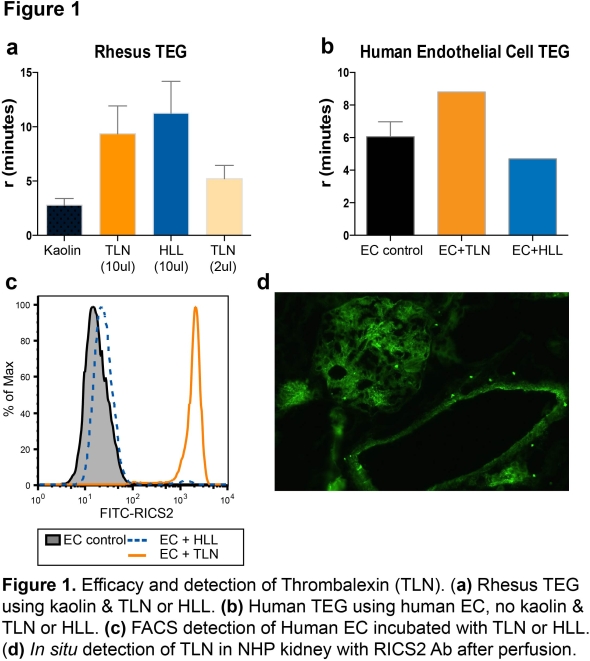Thrombalexin: Detection & Efficacy of a Membrane-Bound Anti-Thrombin Agent.
1Surgery, Duke University, Durham
2King's College, London, United Kingdom.
Meeting: 2016 American Transplant Congress
Abstract number: D68
Keywords: Alloantibodies, Anticoagulation
Session Information
Session Name: Poster Session D: Chimerism/Stem Cells, Cellular/Islet Transplantation, Innate Immunity, Chronic Rejection
Session Type: Poster Session
Date: Tuesday, June 14, 2016
Session Time: 6:00pm-7:00pm
 Presentation Time: 6:00pm-7:00pm
Presentation Time: 6:00pm-7:00pm
Location: Halls C&D
Introduction: Early activation of coagulation may be an important factor in the initiation of innate immunity. Anti-coagulation in the transplant setting is difficult due to post-operative concerns related to increased bleeding risk. A novel 'cytotopic' agent, 'Thrombalexin',(TLN) provides a cell-membrane bound (myristoyl tail) anti-thrombin (HLL peptide) which can be perfused through the donor organ to provide local inhibition of coagulation. We present ex-vivo data to support the use of such an agent in non-human primate (NHP) kidney transplantation.
Method:Thromboelastography (TEG) methods were used to measure time to clot formation (r, in min) in rhesus whole blood, comparing TLN vs HLL peptide only (without cytotopic tail) vs negative kaolin-control, n = 4. Human endothelial cells (EC) were incubated with TLN or HLL, after washing cells were added to whole blood (human), and TEG testing used, without kaolin, to measure anti-coagulant effect. Flow-cytometry was performed detect TLN on EC's using primary mouse monoclonal antibody against HLL (RICS2) and Goat-anti-Mouse (GaM) FITC (GaM), comparing TLN vs HLL vs negative control. NHP kidney was perfused with TLN (2uM) in UW solution and immunohistochemistry (IHC) used to detect membrane-bound TLN using RICS2 and GaM FITC.
Results:TLN & HLL result in significantly prolonged time to clot formation (r) compared to kaolin controls, p = 0.02 (Fig 1.a). Membrane bound TLN on ECs prolongs time to clot formation, compared to HLL or pure EC's (Fig 1.b). Membrane bound TLN is detected by FACS compared to HLL and negative control (Fig 1.c). TLN is detected by IHC within kidney glomeruli and endothelium (Fig 1.d). 
Discussion: TLN is an effective anticoagulant, which can be demonstrated to bind to endothelial cells, and result in an increased time to clot initiation. It should be noted that whole monkey blood is more thrombogenic than human. Perfusion of a discarded kidney with TLN demonstrates glomerular and vascular deposition, in keeping with endothelial cell binding. Further experiments in a sensitized model of NHP kidney transplantation are in progress.
CITATION INFORMATION: Manook M, Kwun J, Yoon J, Sacks S, Dorling A, Mamode N, Smith R, Knechtle S. Thrombalexin: Detection & Efficacy of a Membrane-Bound Anti-Thrombin Agent. Am J Transplant. 2016;16 (suppl 3).
To cite this abstract in AMA style:
Manook M, Kwun J, Yoon J, Sacks S, Dorling A, Mamode N, Smith R, Knechtle S. Thrombalexin: Detection & Efficacy of a Membrane-Bound Anti-Thrombin Agent. [abstract]. Am J Transplant. 2016; 16 (suppl 3). https://atcmeetingabstracts.com/abstract/thrombalexin-detection-efficacy-of-a-membrane-bound-anti-thrombin-agent/. Accessed December 21, 2025.« Back to 2016 American Transplant Congress
